A great way to preserve and use your abundance of blueberries is to make fermented honey blueberries. This super-simple recipe boasts numerous herbal qualities and the sweet taste of summer. It only takes two ingredients and a little time.
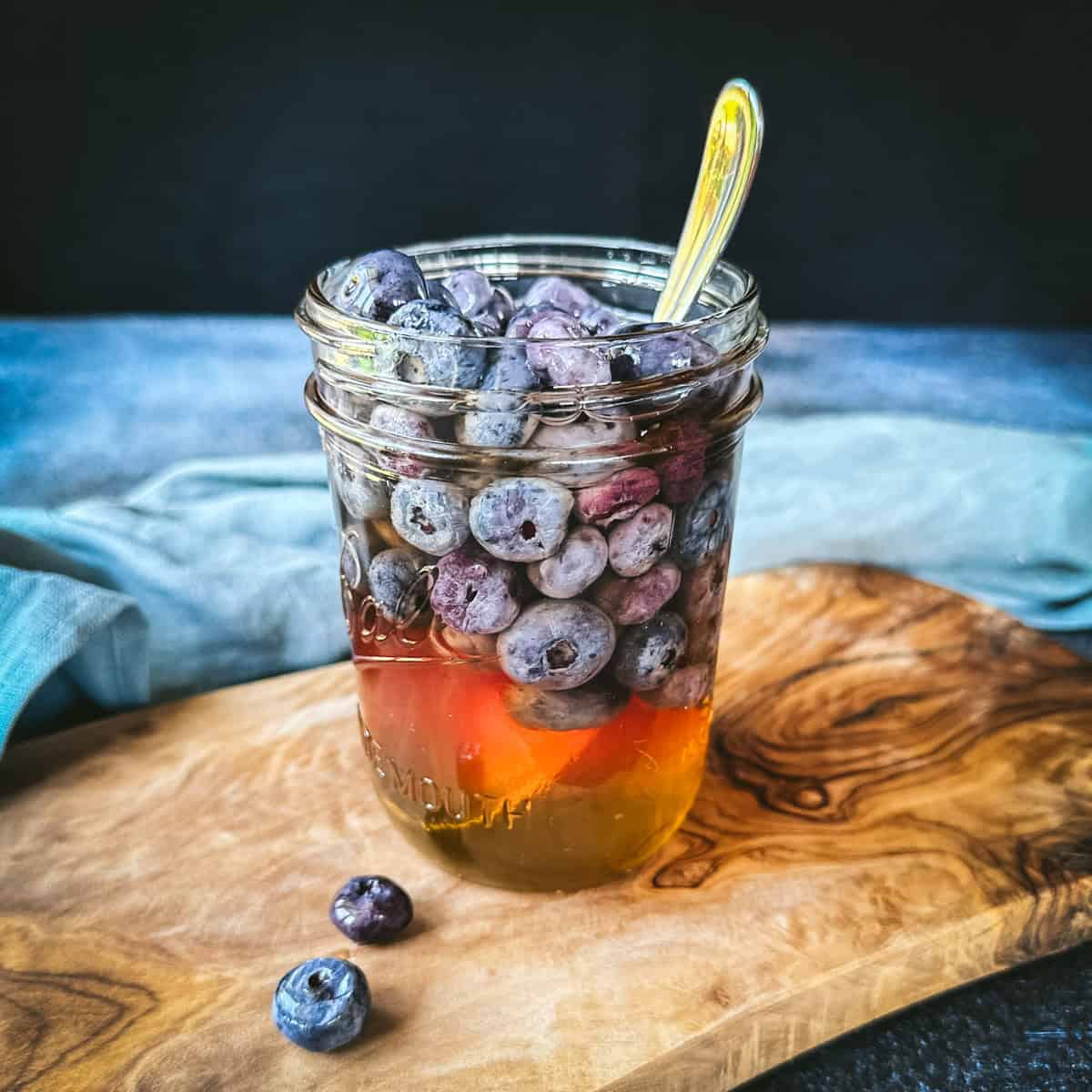
Want to save this post for later?
Raw Honey Benefits
Raw honey is thick and sweet and has many health benefits. Pasteurization kills off the good bacteria and benefits of raw honey, making it unable to ferment.
These are some of the well-studied and wonderful properties of raw honey:
- antioxidant
- immune boosting
- antibacterial
- prebiotic
- good for gut health
When infused with herbs, berries, and other ingredients, raw honey becomes even more of a powerhouse! Making infused honey is an easy way to boost its benefits, like this lilac flower infused honey or pine needle infused honey.
However, my favorite way to use raw honey to its highest capability is to ferment it! Fermented honey garlic and fermented honey cranberries are mainstays in my household.
This recipe for fermented honey blueberries is so simple, and only takes two ingredients. It will become a new favorite for sure!
Blueberries are full of vitamins and antioxidants and have an amazing, earthy, sweet summer flavor. Paired with raw honey and the probiotic benefits of fermentation, they make the healthiest snack ever!
Note: Since this recipe uses raw honey, babies under one year should not eat fermented honey blueberries.
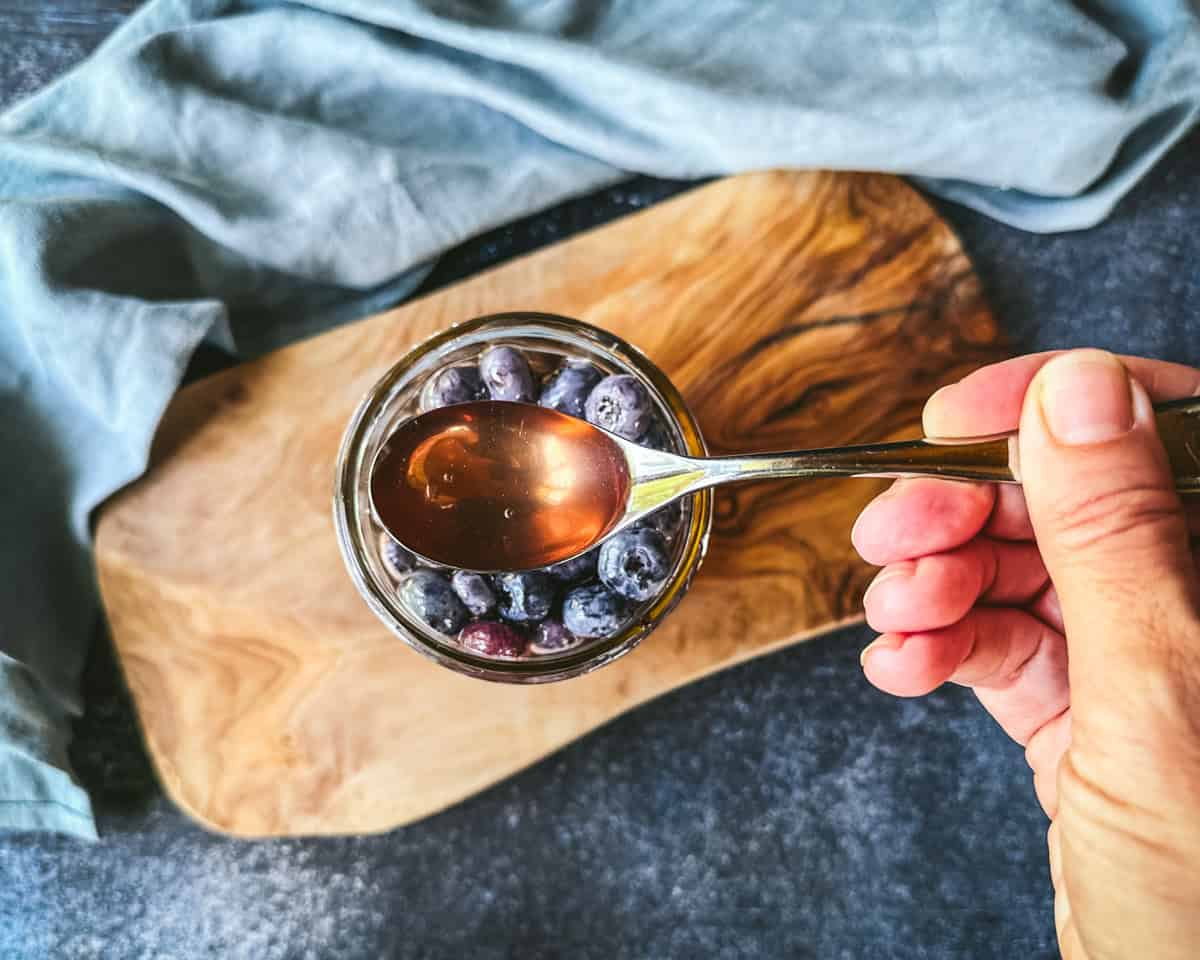
Get more recipes for canning, fermenting, quick pickling, dehydrating, and freezing so that you can enjoy your summer produce year-round in my ebook Preserving the Garden Harvest!
Fermented Honey Blueberries
This recipe is super simple and is the best way to ferment blueberries. The main ingredient, as with all ferments, is time! It’s a sweet season for a berry ferment.
If you have tons of blueberries to use in their ripeness window, it’s easy to make a second or third jar of these! It’s delicious enough to gobble up, or you could share it with friends.
Otherwise, you can freeze any extra berries to preserve them too. Blueberries do great in the freezer. Or make no sugar blueberry jam!
Ingredients
Blueberries: Either homegrown, bought at a farmer’s market, or your favorite local produce store. They should be abundant mid-summer!
Raw honey: It’s important to use raw honey for this recipe, as it contains all the bacteria and wild yeast necessary for fermentation.
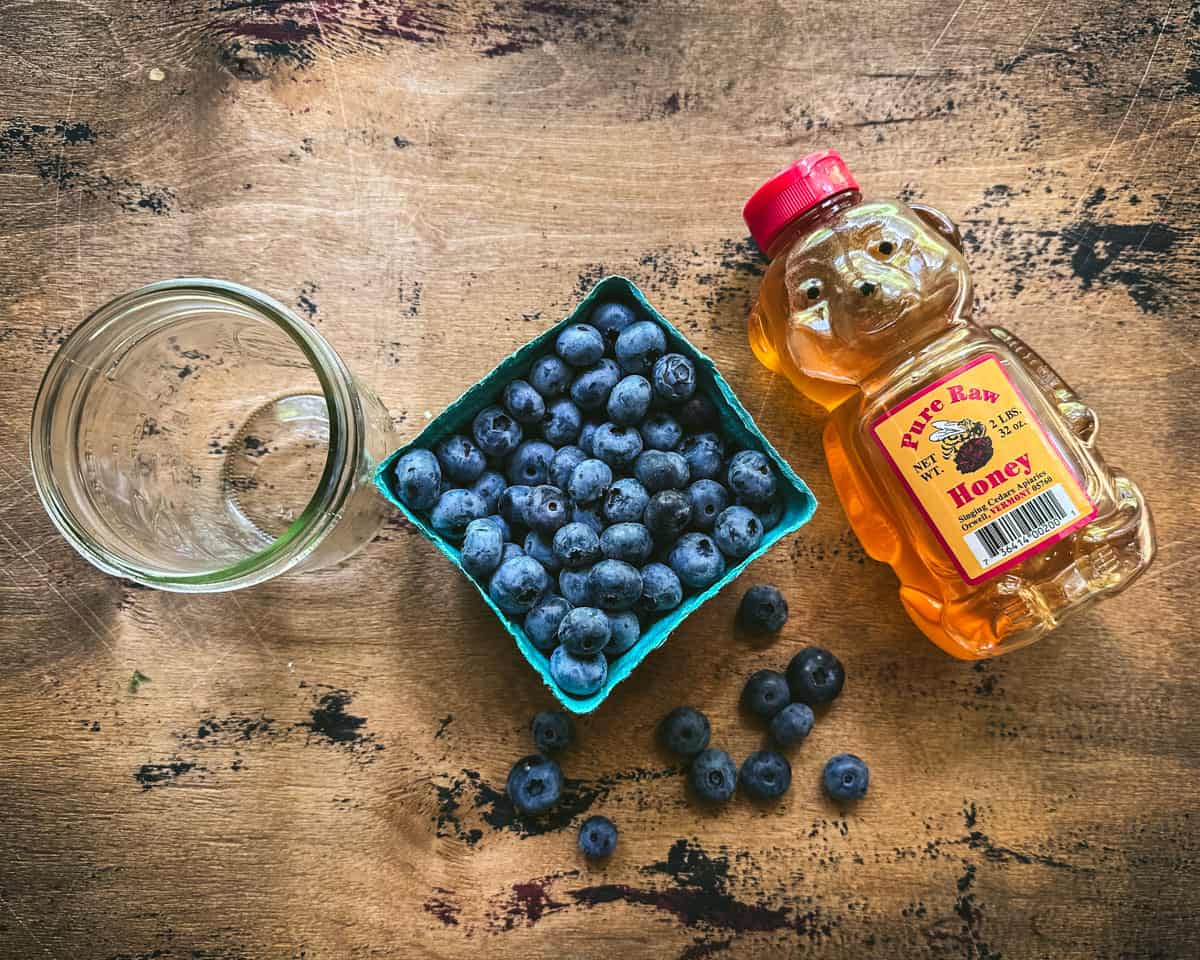
How to Make Blueberry Fermented Honey
First, place the blueberries into a wide-mouth pint-sized mason jar. Make sure to leave an inch or so of space at the top of the jar.
Then, add enough honey to cover the blueberries completely. Rock the jar a little to be sure the blueberries are all coated with honey.
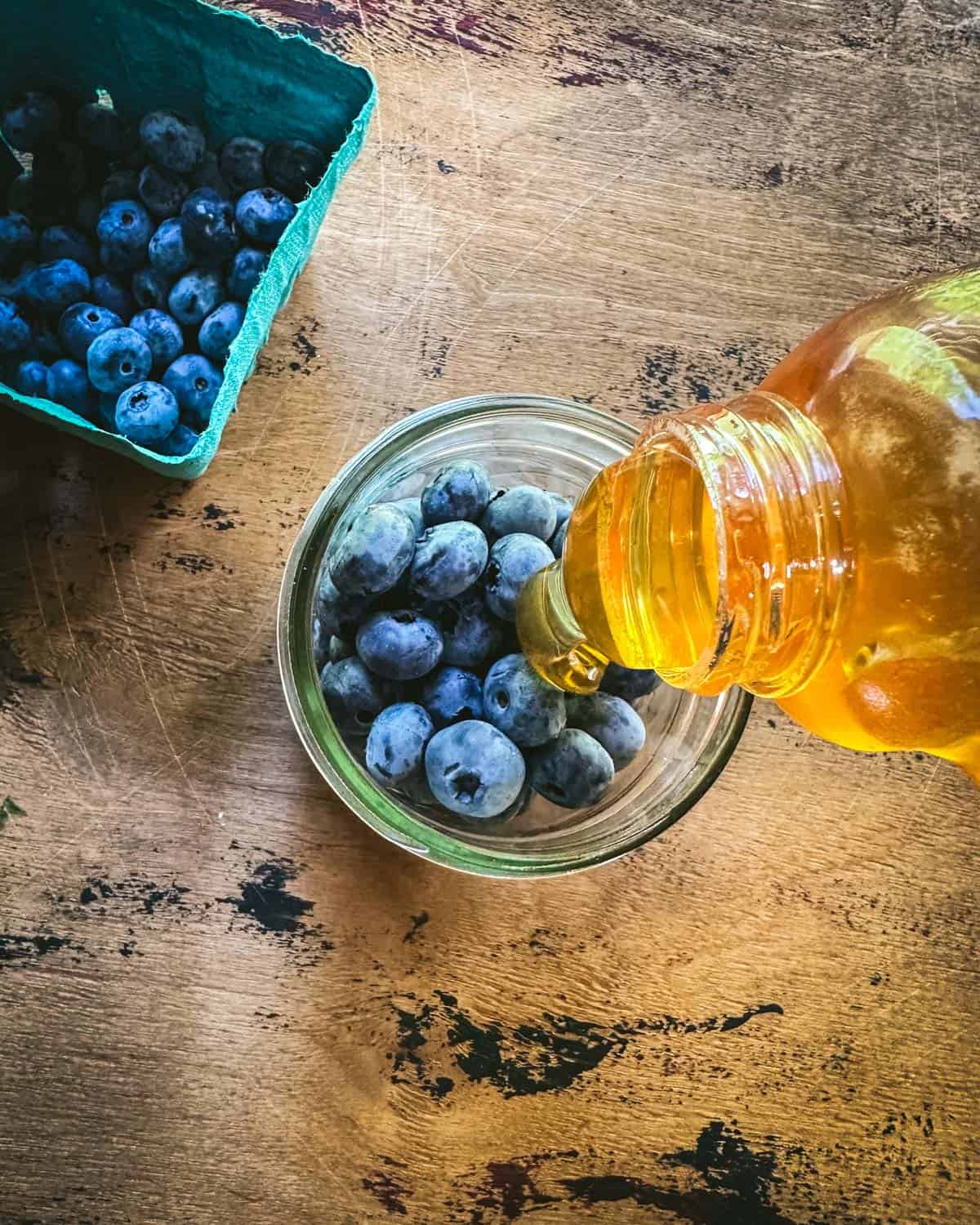
The small amount of juice from the blueberries will create just enough liquid for fermentation to happen, so no other liquid is required.
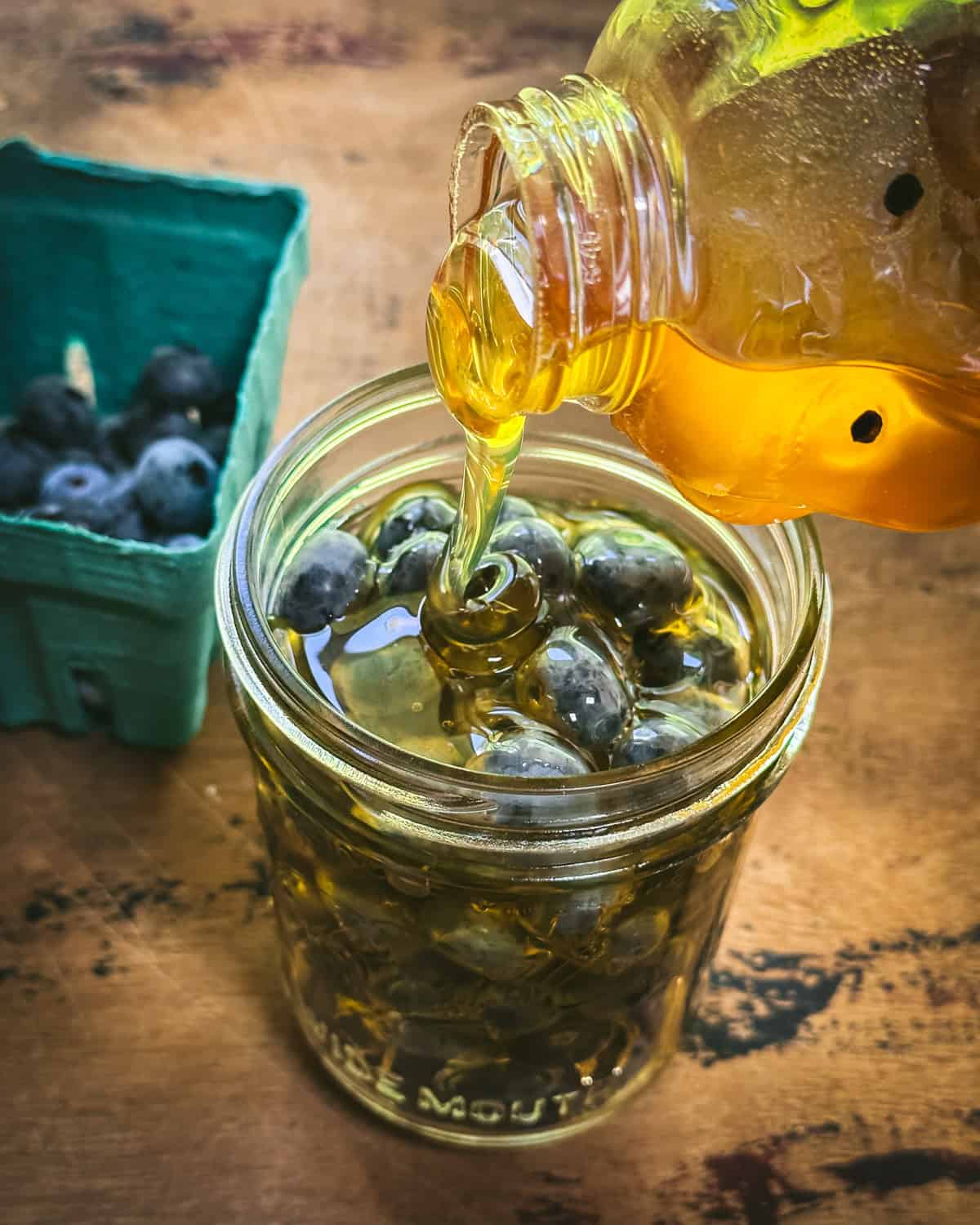
The blueberries will float, but that’s okay—no stress! As long as they’re coated in the honey, they should be good to go.
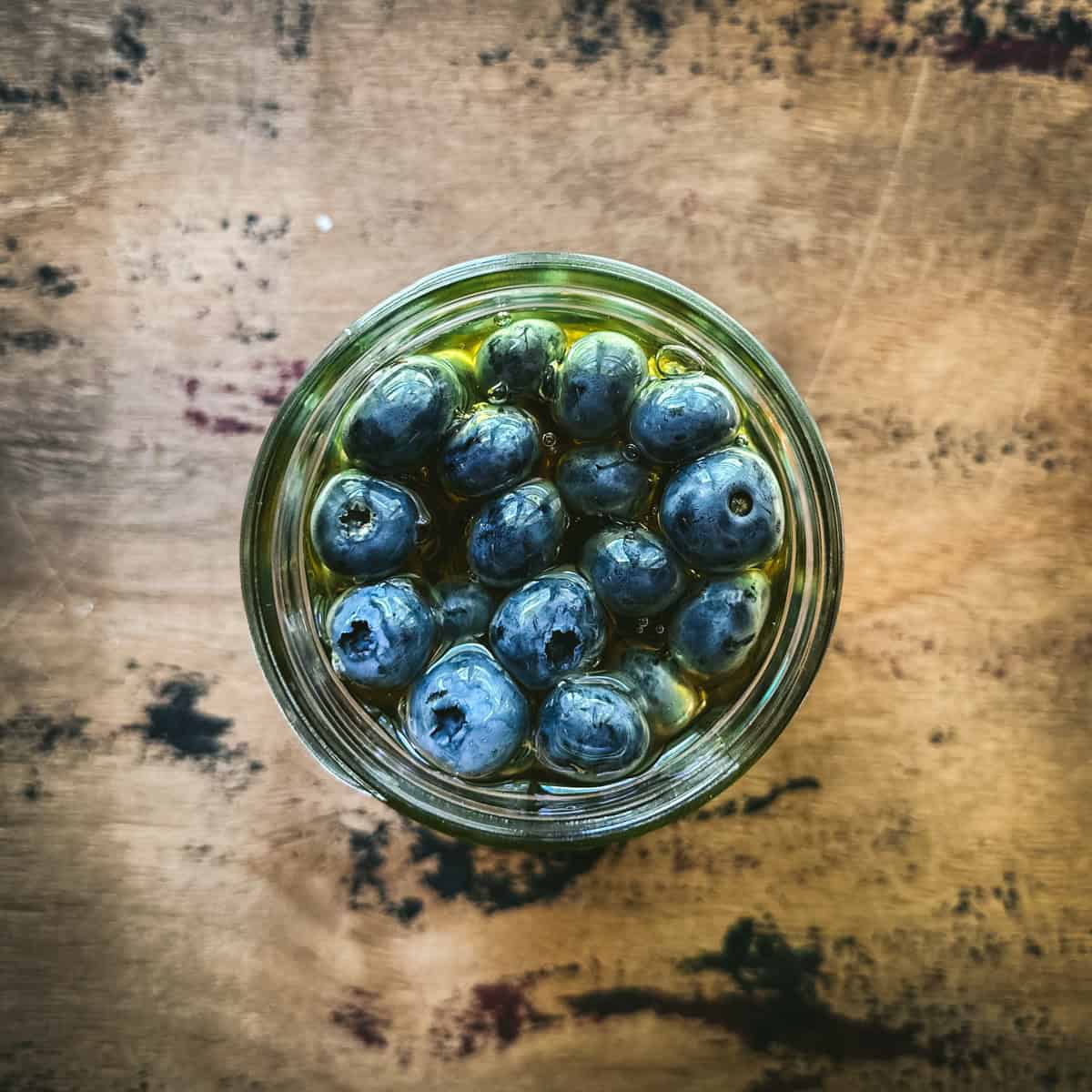
Place the lid on the jar loosely, then tuck it into a dark place out of direct sunlight. A pantry, a shaded corner of a kitchen counter, or a cabinet that you open daily are all good choices.
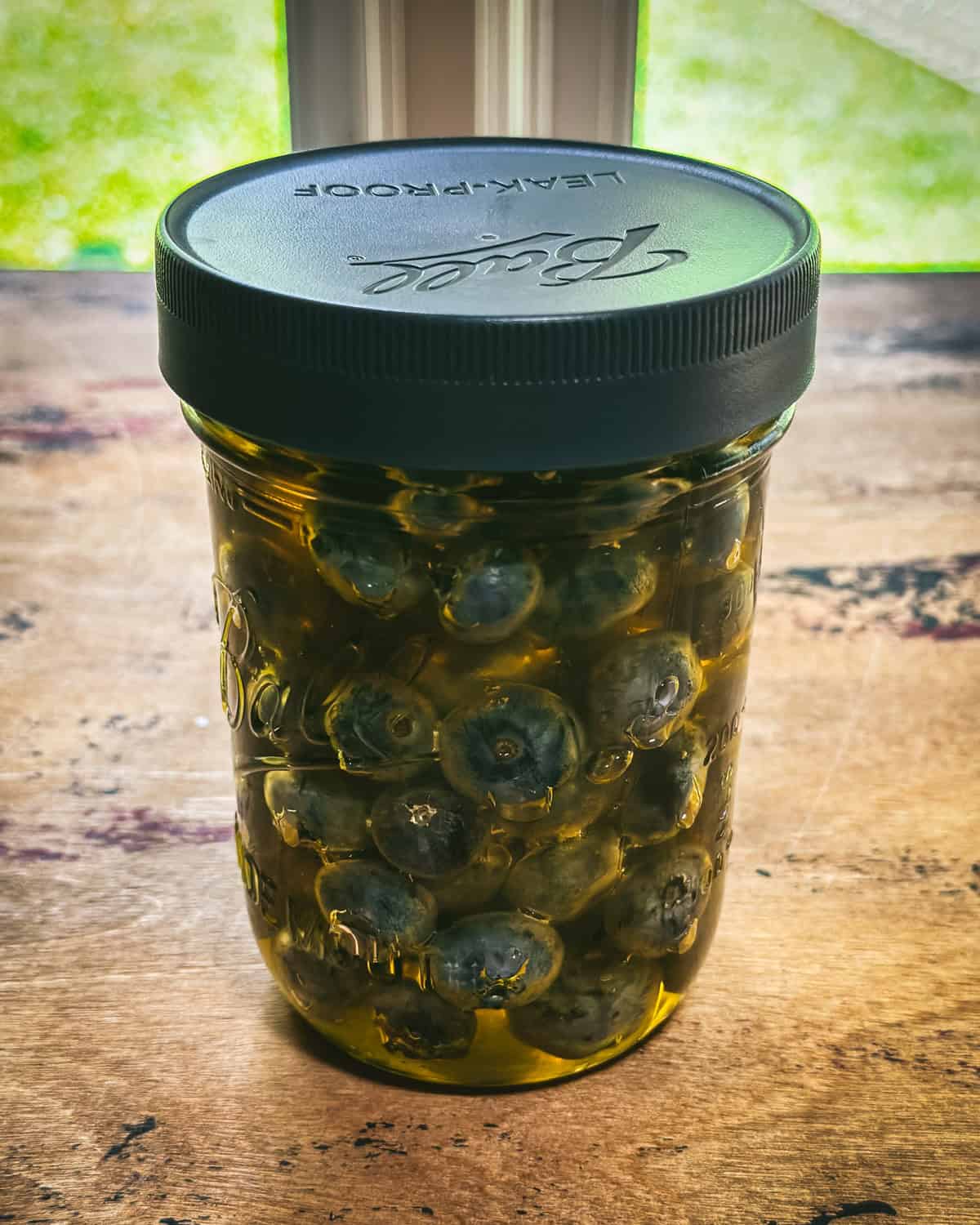
Note: If you are using a metal lid, make sure to put parchment paper in between the jar and the lid. Prolonged contact with metal in a ferment can corrode the metal and leach it into your ferment.
Every day or so, tighten the lid on the jar and flip it upside down to coat the blueberries with honey again. Then, loosen the lid again when you return it upright.
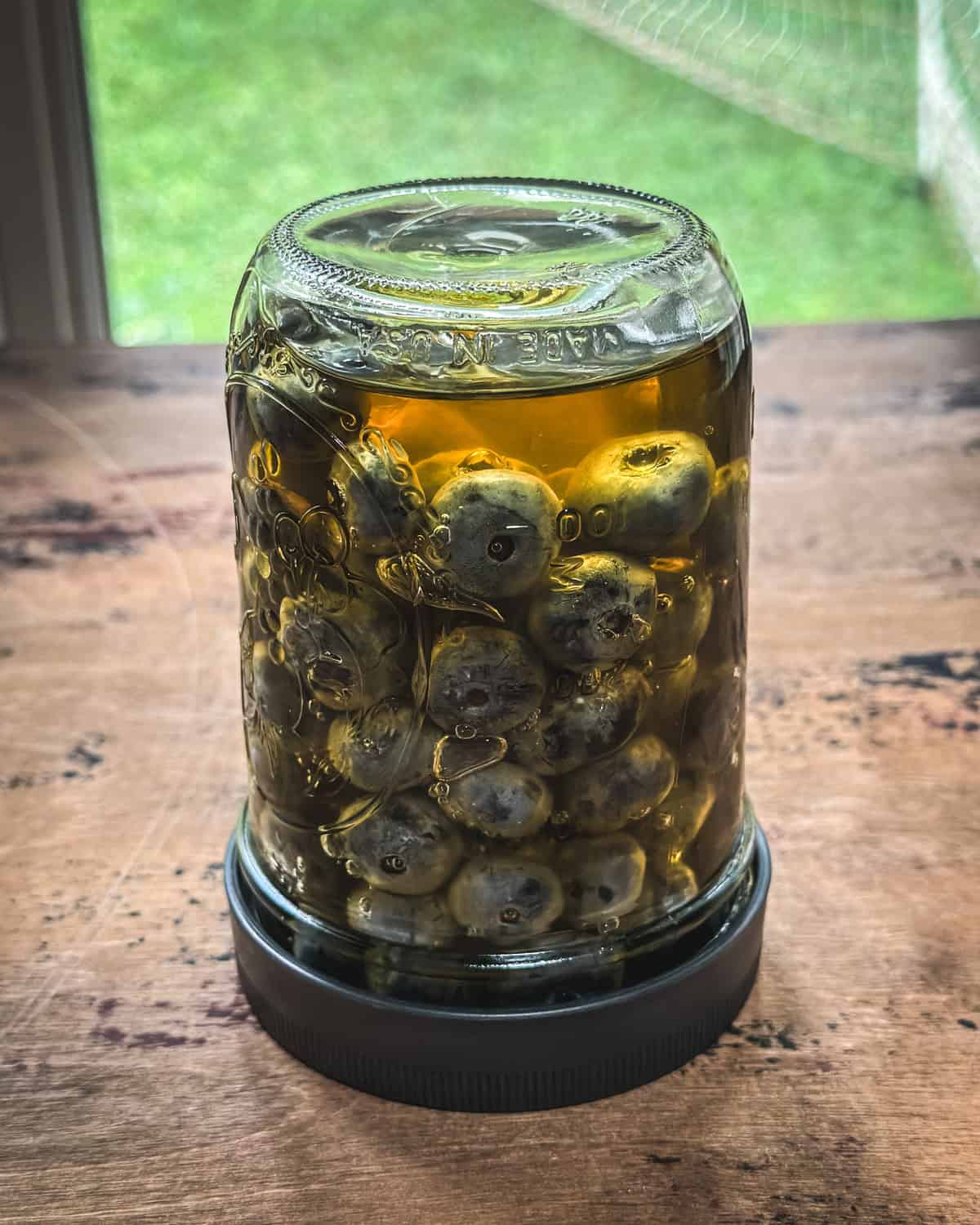
Signs of Fermentation
It’s a good idea to have a plate under the fermentation jar. Sometimes, honey ferments bubble and leak out, which creates a pretty sticky situation. That didn’t happen for me with this one, but it can.
Within a few days to a week, you may start seeing small bubbles start to form on the surface of the honey. Woo hoo! This means things are going well, and the ferment is fermenting.
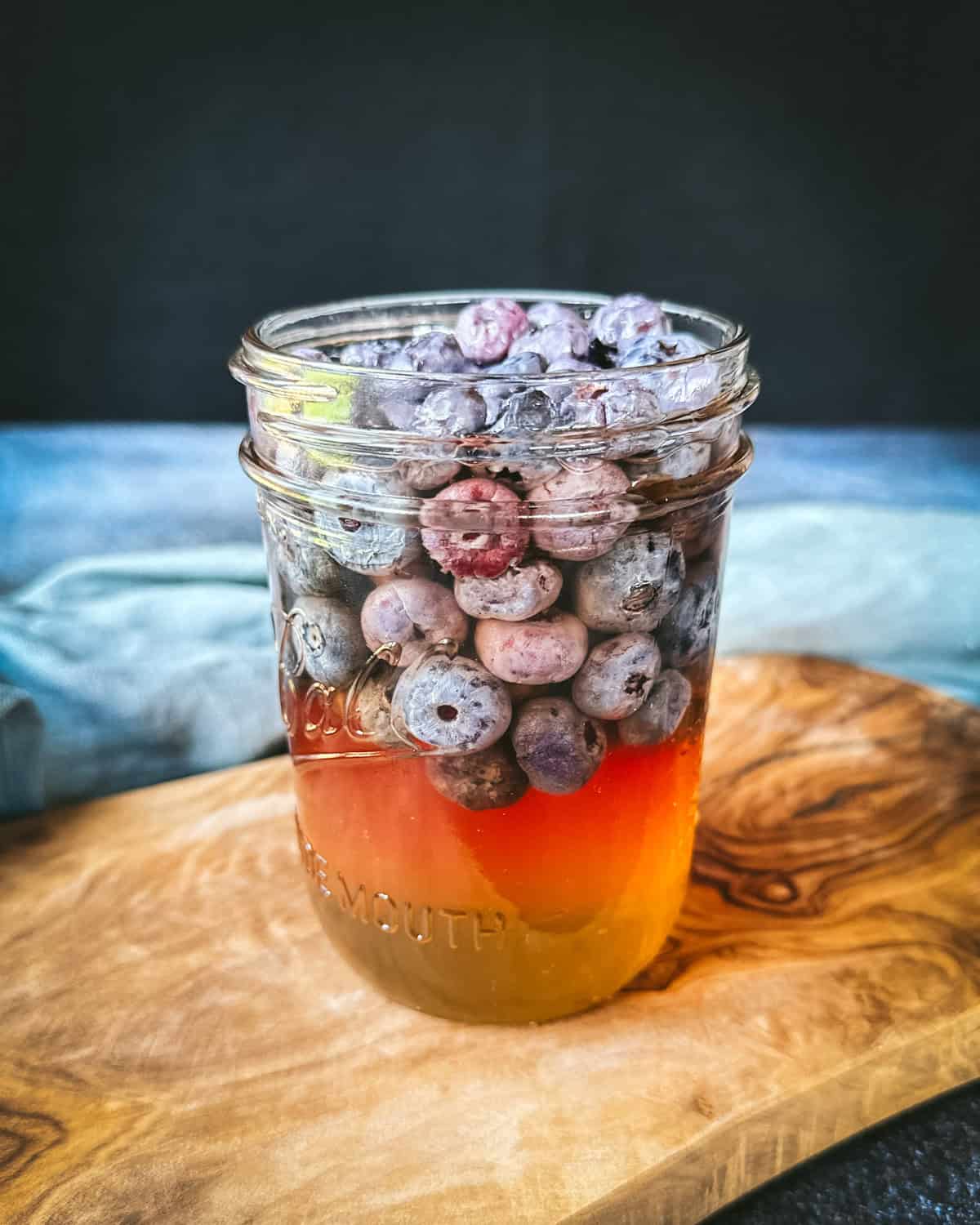
The blueberry honey will ferment for about a month, but you can eat it any time during the fermentation process. The flavor will continue to develop over time, with a sweet and earthy taste.
Expect the blueberries to shrivel a little bit and the honey to become much runnier. It will turn pink or purple in color, similar to the inside flesh of a ripe blueberry!
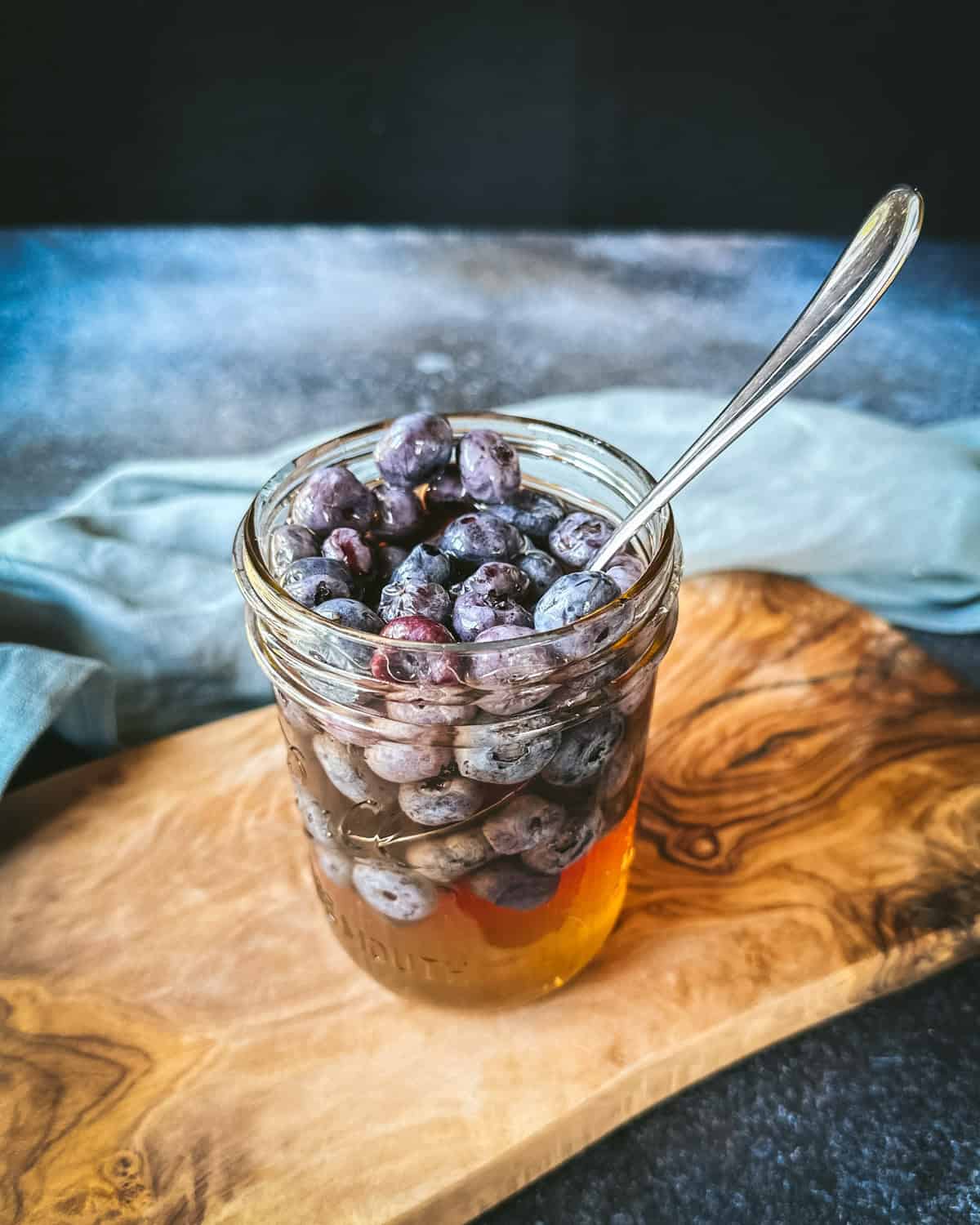
A Quick Botulism Note
Botulism generally isn’t a concern with this type of ferment, but If you are worried, use a pH test strip. Botulism spores can’t reproduce with a pH of less than 4.6. Honey is usually around 3.9, but that can vary between brands. Blueberries will also make the ferment more acidic.
If the pH is too high, add a splash of raw apple cider vinegar to add more acidity and retest. This is generally not needed, but I do want to mention it.
Regardless, it’s recommended that babies under a year old don’t consume raw honey.
How to Store and Eat Fermented Blueberries
Store the fermented blueberry honey in a cool place for many months or even a year, if not longer. Time is on your side with fermented honey!
These blueberries are delicious on their own as a healthy snack, especially if you need a wellness boost. Or, take a spoonful of just the honey!
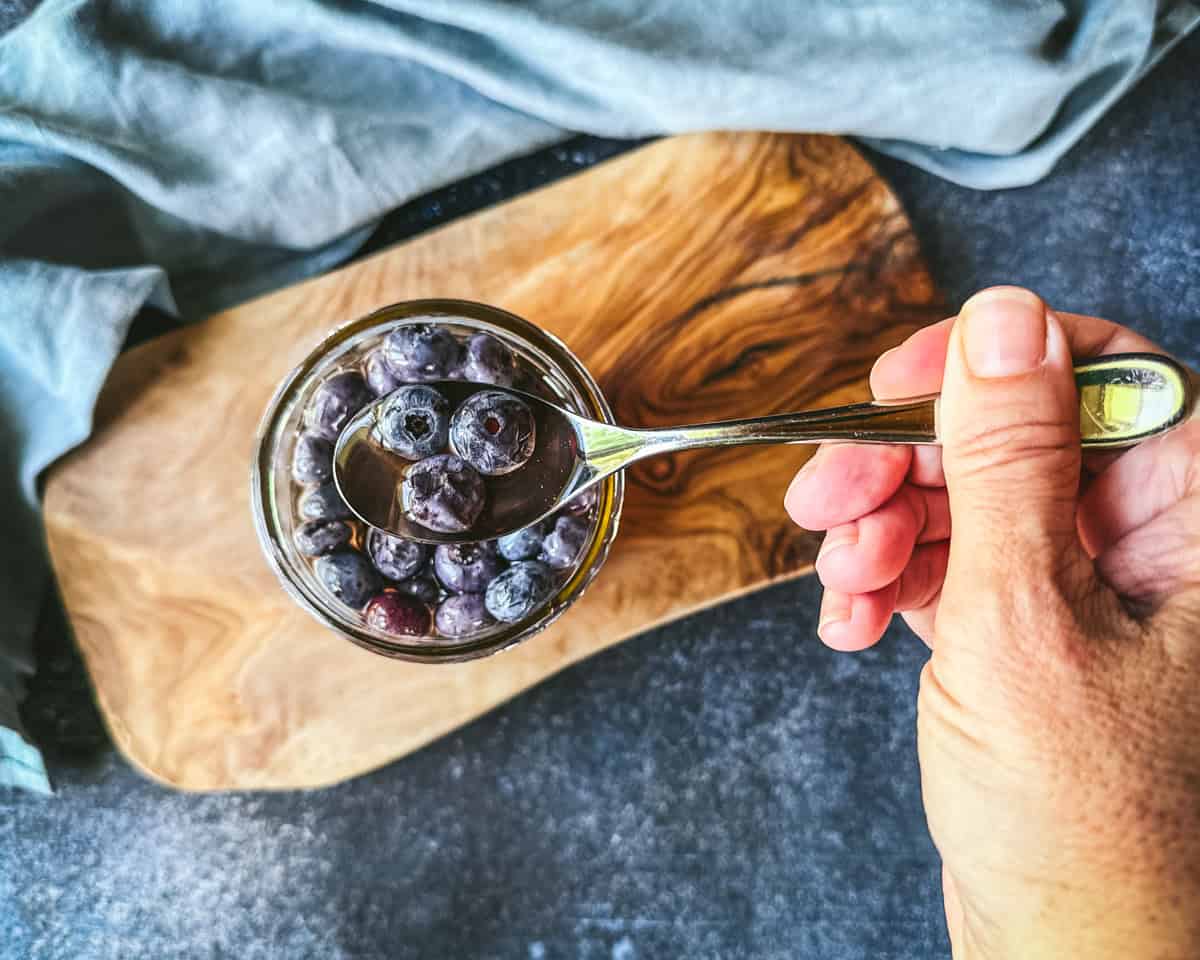
I like adding the blueberry honey to plain yogurt or even on top of ice cream. It’s also delicious drizzled on sourdough blueberry pancakes for an extra blueberry kick.
The honey can sweeten tea or top buttered toast. Use it anywhere you need a little bit of sweetness or a yummy blueberry burst!
More Fermented Honey Recipes
- Fermented Ginger Honey
- Fermented Jalapeño Honey
- Fermented Honey Garlic
- Fermented Elderberry Honey
- Fermented Honey Cranberries
- 8 Fermented Honey Recipes
Fermented Honey Blueberries
Equipment
Ingredients
- 2 cups blueberries
- 1 cup raw honey more or less as needed to cover blueberries
Instructions
- Place the blueberries into a wide-mouth pint-sized mason jar, leaving an inch or so of space at the top of the jar. Add enough honey to cover the blueberries completely. Make sure the blueberries are coated with honey. The blueberries will float, but that is ok.
- Place the lid on the jar loosely, then tuck it into a dark place.
- Every day or so, tighten the lid on the jar and flip it upside down to coat the blueberries with honey. Loosen the lid again when you return it to the upright position.
- Within a few days to a week, you may start seeing small bubbles start to form on the surface of the honey.
- The blueberry honey will ferment for about a month, but you can eat it at any time. The flavor will continue to develop over time, the blueberries will shrivel a bit, and the honey will become much runnier and will be pink or purple in color.
- Store the fermented blueberry honey in a cool place for many months or even a year, if not longer.
Notes
- It’s important to use raw honey for this recipe, as it has all of the bacteria and wild yeast that are necessary for fermentation.
- The small amount of juice from the blueberries will create just enough liquid for fermentation to happen.
- It’s a good idea to put a plate underneath the jar during fermentation, as it may bubble up, and a little bit of honey could possibly drip out.
- If you are concerned about botulism, use a pH test strip. Botulism spores can’t reproduce with a pH of less than 4.6. Honey is usually around 3.9, but that can vary between brands.
- If the pH is too high, add a splash of raw apple cider vinegar to add more acidity and retest. This is generally not needed, but I do want to mention it.
- Blueberry honey should not be given to babies under one year of age.

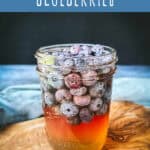



Hello! I have wanted to begin fermenting and this seems like a great way to ease in! Would I need to keep the lid loose indefinitely?
No, just until the bubbles stop coming to the surface.
I’m fermenting in honey for the first time. I have pickle pipe lids and weights. You don’t say to use them, but since I have them I thought I would use the weight to keep the blueberries submerged in the honey. Will that work?
Thanks! Headed out for cranberries so I can try your fermented cranberries recipe.
That should be fine!
I started this process and allowed the blueberries to ferment for about 5 weeks. The ferment worked perfectly!! The deliciousness is simply too good for mere words. I did not care for the shrivelled blueberries (after 5 weeks) so I kept just the honey. Now the trick is not to eat it voraciously until it’s all gone! I am now going to try other suggested honey ferments.
Wonderful! I’m so happy you liked this recipe, Anne!
Can you use frozen blueberries?
That should work!
Thank you for all that you share. Your education and willingness to share is deeply appreciated.
I have learned so much from your newsletter and social media platforms.
I made honey fermented blueberries once and ended up with mead. It was a delicious surprise.
I think this may be happening to mine. The liquid has become very thin and it bubbles like a warm beer. How do I handle it from here??
Hi. First off I’d like to say I absolutely love your newsletter and make a lot of your recipes. I’m very grateful.
My question is have tried to honey ferment aronia chokeberries this way? I’ve got a huge harvest this year. Thank you.
Hi Cathy! I’m so glad you love my newsletter. I have not tried using aronia berries, but I’d imagine they’d ferment the same way. Give it a shot and let me know how they are!